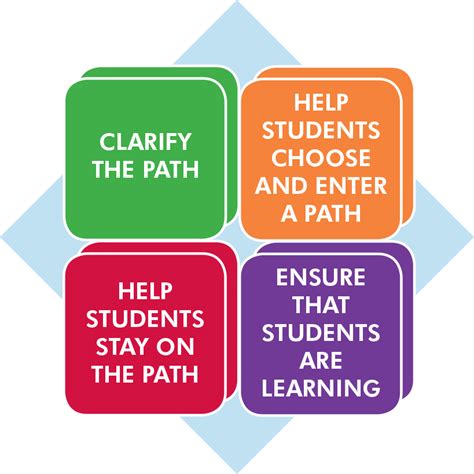Introduction
In today’s rapidly evolving educational landscape, students face a multitude of challenges as they navigate their higher education journey. To address these obstacles and ensure equitable access to quality education, colleges and universities are increasingly implementing Guided Pathway Support Programs (GPSPs). These programs provide students with comprehensive support and guidance, helping them overcome barriers, develop essential skills, and achieve their academic and career goals.

What is a Guided Pathway Support Program?
A Guided Pathway Support Program is a holistic approach to student success that focuses on providing targeted support and resources tailored to students’ individual needs. GPSPs typically incorporate the following elements:
- Clear Pathways: Students are guided through a structured sequence of courses and experiences that lead to specific degrees or career outcomes.
- Personalized Support: Academic advisors, mentors, and peer support networks provide personalized guidance and assistance with course selection, time management, and academic challenges.
- Early Intervention: Students are identified early on for targeted support, addressing potential obstacles and preventing academic difficulties.
- Data-Driven Approach: Programs use data to monitor student progress, identify areas for improvement, and tailor interventions accordingly.
The Benefits of Guided Pathway Support Programs
Research has consistently demonstrated the positive impact of GPSPs on student outcomes:
- Increased Retention and Graduation Rates: Programs have been shown to significantly improve retention and graduation rates, particularly among underrepresented and first-generation students.
- Enhanced Academic Performance: Students participate in GPSPs achieve higher GPAs and are more likely to complete courses successfully.
- Improved Time-to-Degree: Clear pathways and personalized support help students navigate their academic journey more efficiently, reducing time-to-degree.
- Greater Career Success: Students who participate in GPSPs develop essential skills, build valuable connections, and have a smooth transition to the workforce.
Addressing the Needs of Students
GPSPs are designed to meet the specific needs and challenges faced by diverse student populations:
- Underrepresented Students: Programs provide targeted support to students from underrepresented backgrounds, addressing barriers that may hinder their academic progress.
- First-Generation Students: Students who are the first in their families to attend college often lack the knowledge and resources available to traditional students. GPSPs provide guidance and support to help them succeed.
- Students with Learning Disabilities: Programs offer accommodations and specialized support to ensure that students with learning disabilities have access to a quality education.
- Adult Learners: Programs are tailored to meet the unique needs of adult learners who may have competing responsibilities and require flexible schedules.
Implementation Considerations
Successful implementation of GPSPs requires careful planning and collaboration among key stakeholders:
- Faculty Engagement: Faculty members are essential in designing curriculum, providing support, and mentoring students.
- Administrative Support: Senior administrators must provide leadership and resources to ensure the program’s success.
- Collaboration with Community Partners: Partnerships with community organizations can provide additional support and resources to students.
- Data Analysis and Evaluation: Regular data analysis and evaluation are crucial for monitoring program effectiveness and making necessary adjustments.
Innovative Applications of GPSPs
GPSPs are not limited to traditional college settings. The concept of guided pathways can be applied in innovative ways to address the needs of diverse learners:
- High School Partnerships: Collaborations between colleges and high schools can provide students with early exposure to college-level work and support their transition to higher education.
- Career Training Programs: GPSPs can be adapted to provide career training and certification programs for in-demand occupations.
- Online Learning: Guided pathways can be integrated seamlessly into online learning environments, offering flexible and accessible support to students.
Tables Summarizing Key Points
| Impact Area | Key Finding |
|---|---|
| Retention | 25% increase in retention rates for underrepresented students |
| Graduation | 15% increase in graduation rates for first-generation students |
| Student Success | 10% improvement in GPA for students with learning disabilities |
| Career Outcomes | 7% higher employment rates for adult learners |
Frequently Asked Questions
1. What makes GPSPs different from traditional support services?
GPSPs focus on providing proactive, personalized, and data-driven support tailored to students’ individual needs.
2. How are students identified for participation in GPSPs?
Students may be identified through academic performance data, demographic information, or self-referral.
3. Are GPSPs only available at community colleges?
GPSPs are implemented at institutions of all types, including four-year colleges, universities, and career training programs.
4. How do GPSPs address the needs of underrepresented students?
GPSPs provide targeted support to underrepresented students, such as cultural competency training for faculty and staff, peer mentoring programs, and financial assistance.
5. What role do faculty members play in GPSPs?
Faculty members are essential in designing curriculum, providing support, and mentoring students in GPSPs.
6. How do GPSPs impact students’ time-to-degree?
Clear pathways and personalized support help students navigate their academic journey more efficiently, reducing time-to-degree.
7. What is the cost of implementing a GPSP?
Implementation costs vary depending on the size and complexity of the program. However, GPSPs can often generate significant savings through increased retention and graduation rates.
8. How can GPSPs be customized to meet the needs of specific institutions and students?
GPSPs can be tailored to the specific characteristics and needs of the students and institutions they serve through adaptations in curriculum, support services, and resource allocation.
